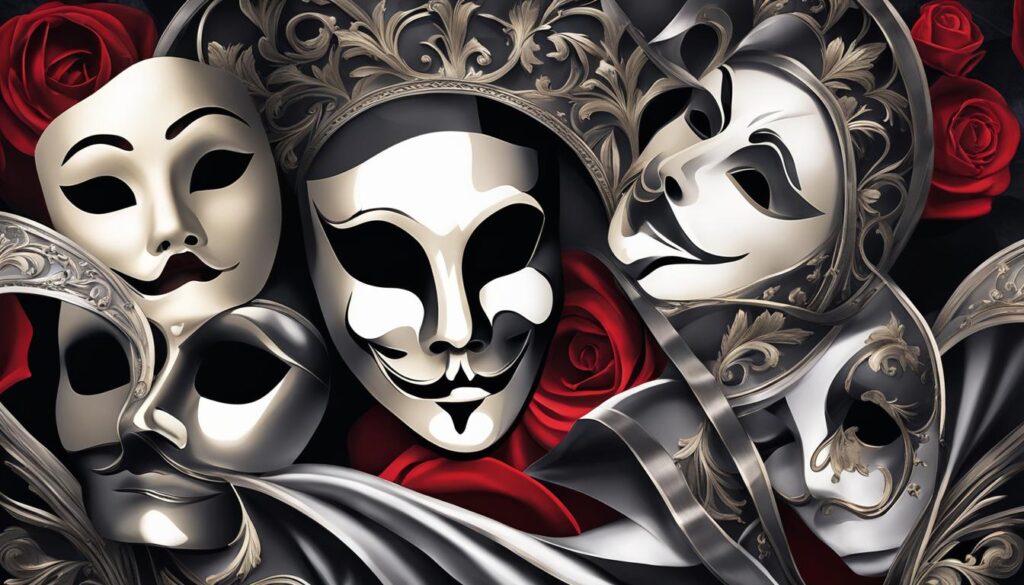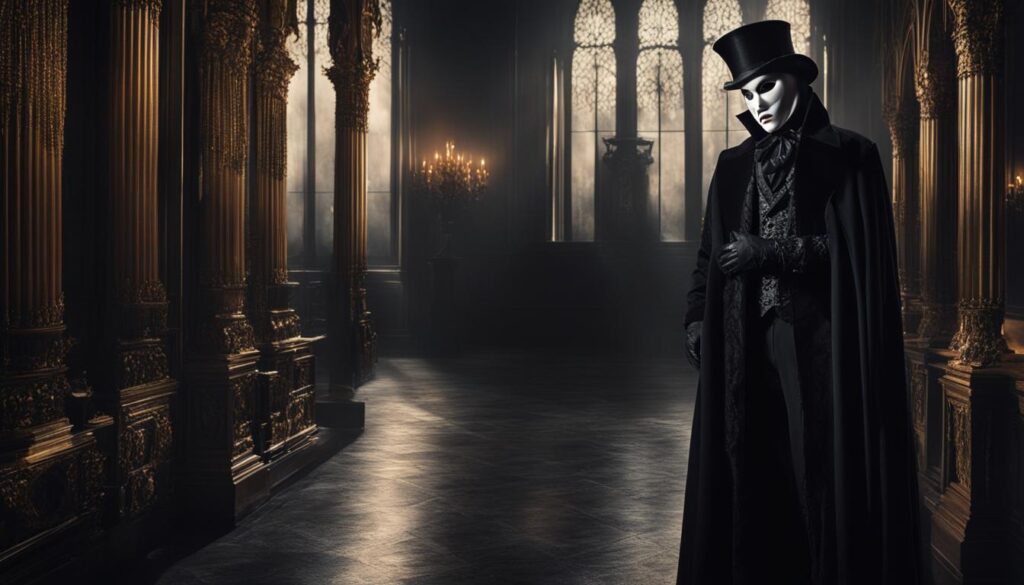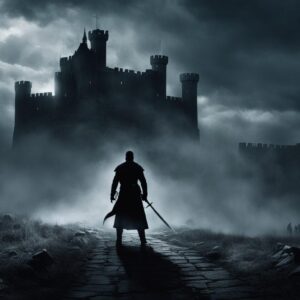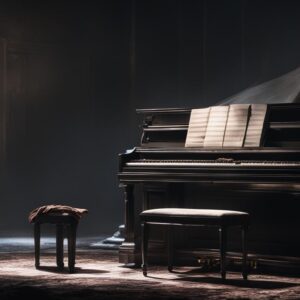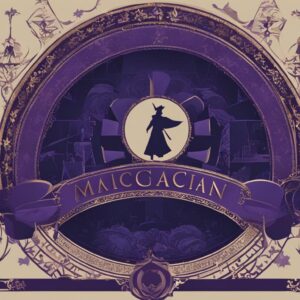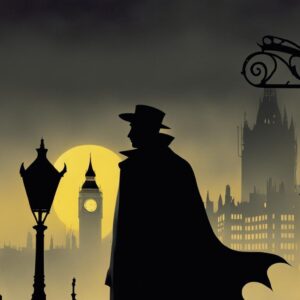Welcome to my blog post where I dive into the timeless allure of The Phantom of the Opera (1925), a classic film that holds a special place in the history of silent cinema. This captivating masterpiece has mesmerized audiences for decades with its gothic romance and iconic monster. Starring the legendary Lon Chaney as the Phantom, this film, released by Universal Pictures, has solidified its position in film history.
Key Takeaways:
- The Phantom of the Opera (1925) is a classic film in the history of silent cinema.
- Lon Chaney’s portrayal of the Phantom is legendary.
- Released by Universal Pictures, this masterpiece has enduring appeal.
- The film showcases the gothic romance and iconic monster of the story.
- The Phantom of the Opera (1925) is a must-watch for any film enthusiast.
The Musical Phenomenon of The Phantom of the Opera
The musical adaptation of The Phantom of the Opera has taken the world by storm, captivating audiences with its enchanting storyline and unforgettable music. Created by the acclaimed duo Andrew Lloyd Webber and Cameron Mackintosh, the musical first premiered in London’s West End in 1986 and has since become one of the most successful and longest-running shows in theater history. It has been staged in countless countries, including multiple productions on Broadway, earning critical acclaim and amassing a dedicated fan base.
The allure of The Phantom of the Opera lies in its ability to transport audiences into a world of mystery, romance, and tragedy. The captivating storyline follows the journey of Christine Daaé, a young opera singer who becomes entangled in a complex love triangle with the enigmatic and disfigured Phantom and her childhood friend Raoul. The emotional depth and complexity of the characters, combined with Andrew Lloyd Webber’s mesmerizing score, including iconic songs like “The Music of the Night” and “All I Ask of You,” have made the musical an unforgettable theatrical experience.
The success of The Phantom of the Opera can also be attributed to its breathtaking production values. From the stunning sets and elaborate costumes to the innovative use of special effects, the show creates a visually captivating spectacle that immerses the audience in the grandeur of the Paris Opera House. The combination of exceptional performances, lavish production design, and Andrew Lloyd Webber’s masterful storytelling has solidified The Phantom of the Opera as a cultural phenomenon and a must-see theatrical event.
In summary, the musical adaptation of The Phantom of the Opera has become a global sensation, enchanting audiences with its captivating storyline, iconic music, and stunning theatrical production. Its enduring popularity and continued success are a testament to the timeless allure and universal appeal of this beloved classic.
The Origins of The Phantom of the Opera
Before becoming an iconic silent film and a sensational musical, The Phantom of the Opera originated from the imaginative mind of Gaston Leroux. In 1911, Leroux published his original novel, which would go on to capture the hearts and imaginations of readers around the world.
Leroux’s novel tells the story of a disfigured musical genius named Erik, who resides beneath the Paris Opera House. The tale weaves together elements of mystery, romance, and horror, creating a captivating narrative that has stood the test of time.
“Behind this mask there is more than just flesh. Beneath this mask there is an idea… and ideas are bulletproof.” – Gaston Leroux
The Phantom of the Opera delves into themes of love, desire, and sacrifice, exploring the complex relationships between its main characters. Erik’s longing for love and acceptance, Christine Daae’s struggle with her feelings for Erik and her childhood friend Raoul de Chagny, and the ensuing love triangle all contribute to the enduring allure of the story.
The Fascination with Leroux’s Original Novel
Leroux’s original novel continues to captivate readers to this day, providing a deeper exploration of the characters and their motivations. The enigmatic nature of the Phantom and the tragic love story at the heart of the narrative have cemented The Phantom of the Opera as a classic in literary history.
| Key Elements | Description |
|---|---|
| Mystery | The novel is filled with suspense and intrigue as readers uncover the secrets of the Phantom and the Paris Opera House. |
| Romance | The love story between Erik, Christine, and Raoul is a central theme, showcasing the power of love and the sacrifices made for it. |
| Horror | Leroux’s novel delves into the darker aspects of human nature, presenting a haunting tale of obsession and madness. |
The Silent Film Adaptation
In 1925, the iconic silent film adaptation of The Phantom of the Opera was released, starring Lon Chaney in the unforgettable role of the Phantom. This horror movie, based on Gaston Leroux’s original novel, remained faithful to the gripping narrative and showcased Chaney’s incredible talent for makeup and physical performance. The film’s atmospheric visuals and Chaney’s haunting portrayal contributed to its status as a classic in the horror genre.
The Phantom of the Opera (1925) transported audiences into the dark and mysterious world of the Paris Opera House, where the Phantom lurked in the catacombs beneath. Through the use of innovative camera techniques and dramatic lighting, the film created a sense of unease and suspense, capturing the essence of the gothic romance that lies at the heart of the story.
“Lon Chaney’s performance as the Phantom is nothing short of mesmerizing. His transformation into the disfigured musical genius is a testament to his incredible acting skills and the power of practical effects. Chaney’s ability to convey a wide range of emotions, from haunting sadness to violent rage, is what makes his portrayal so captivating and memorable.”
The silent film adaptation of The Phantom of the Opera stands as a testament to the enduring power of this beloved story. It continues to captivate audiences with its timeless tale of love, obsession, and tragedy, cementing its place as a horror movie classic and a significant contribution to film history.
Lon Chaney’s Haunting Performance
In the role of the Phantom, Lon Chaney delivered a mesmerizing and haunting performance that has become legendary in the world of cinema. Known as the “Man of a Thousand Faces,” Chaney’s ability to transform himself through makeup and physicality was unparalleled. His portrayal of the disfigured and tormented Phantom captured the imagination of audiences and solidified his status as one of the greatest actors of the silent era.
| Aspect | Description |
|---|---|
| Makeup | Lon Chaney’s makeup in The Phantom of the Opera remains iconic to this day. Through the use of prosthetics, he created a chilling and realistic portrayal of the Phantom’s disfigurement. |
| Physical Performance | Chaney’s physicality in the role was equally impressive. From his menacing presence to his graceful movements, he brought the character of the Phantom to life in a way that left a lasting impression on audiences. |
| Emotional Range | One of Chaney’s greatest strengths as an actor was his ability to convey a wide range of emotions. In The Phantom of the Opera, he seamlessly transitioned from moments of heart-wrenching vulnerability to terrifying displays of rage, creating a complex and multi-dimensional character. |
Lon Chaney’s performance in the silent film adaptation of The Phantom of the Opera remains a masterpiece of cinematic artistry. His portrayal of the tormented Phantom continues to captivate and terrify audiences, solidifying his place as a true legend of the silver screen.
The Allure of the Gothic Romance
The Phantom of the Opera is not only a horror movie but also a gothic romance. The story explores themes of love, desire, and sacrifice, creating a tragic tale of a disfigured outcast searching for acceptance and affection. The allure of the gothic romance in The Phantom of the Opera lies in its portrayal of intense emotions, forbidden love, and the struggles faced by the characters.
The Intensity of Emotions
In The Phantom of the Opera, the characters experience a range of intense emotions that drive the narrative forward. The Phantom’s unrequited love for Christine Daae fuels his obsession and drives him to desperate measures. Christine, torn between her loyalty to the Phantom and her growing affection for Raoul, represents the struggle between duty and desire. These conflicting emotions create a sense of tension and drama that captivates the audience and keeps them emotionally engaged with the story.
“The Phantom’s love for Christine is both passionate and tragic, evoking a sense of longing and empathy in the audience.” – Anonymous critic
Forbidden Love and Intrigue
One of the central themes in gothic romance is forbidden love, and The Phantom of the Opera exemplifies this concept. The relationship between the Phantom and Christine is shrouded in secrecy and danger, adding an element of forbidden desire to their connection. The clandestine nature of their interactions and the Phantom’s constant presence in the shadows create a sense of intrigue and suspense throughout the story. The audience is drawn into their forbidden love affair, eagerly following their every interaction while knowing that tragedy is inevitable.
The Tragic Arc of the Characters
The Phantom of the Opera masterfully weaves a tragic narrative that unfolds before the audience’s eyes. The disfigurement of the Phantom and his ensuing isolation highlight the theme of societal rejection and the search for acceptance. The Phantom’s yearning for love and his inability to find it due to his physical appearance create a deep sense of sympathy for his character. The tragic arc of the characters, particularly the Phantom and Christine, evokes a profound emotional response from the audience, leaving a lasting impression long after the final curtain falls.
| Elements of Gothic Romance in The Phantom of the Opera | Description |
|---|---|
| Dark and Atmospheric Setting | The Paris Opera House serves as a haunting backdrop for the story, creating an atmosphere of mystery and intrigue. |
| Supernatural Elements | The presence of the Phantom and his otherworldly abilities adds a supernatural element to the narrative, heightening the sense of gothic romance. |
| Conflict between Light and Dark | The contrast between the Phantom’s darkness and Christine’s innocence represents the timeless conflict between light and dark, good and evil. |
| Tragic Love Triangle | The love triangle between the Phantom, Christine, and Raoul showcases the complexities of forbidden love and the tragic consequences that ensue. |
The Enduring Legacy of The Phantom of the Opera
The Phantom of the Opera (1925) has left an indelible mark on film history. Its innovative use of makeup and special effects, particularly Lon Chaney’s striking appearance as the Phantom, set a precedent for future monster movies. The enduring legacy of this film is evident in its influence on the horror genre and its continued popularity among audiences.
Throughout film history, The Phantom of the Opera (1925) has been celebrated for its groundbreaking techniques. Lon Chaney’s iconic portrayal of the disfigured Phantom is as frightening as it is captivating. His transformation into the monstrous character was achieved through meticulous makeup and prosthetic application, creating an unforgettable image that has become synonymous with the film.
But it’s not just the visuals that have contributed to the lasting impact of The Phantom of the Opera. The film’s atmospheric cinematography, haunting score, and gripping storyline have all played a role in its enduring appeal. Audiences continue to be drawn to the tragic tale of the Phantom’s unrequited love and the terror he unleashes upon the Paris Opera House.
The influence of The Phantom of the Opera (1925) extends beyond the realm of cinema. Its success paved the way for future adaptations and reinterpretations in various mediums, including stage productions and remakes. The enduring popularity of the story is a testament to its universal themes of love, obsession, and the duality of human nature.
In conclusion, The Phantom of the Opera (1925) stands as a testament to the power of storytelling in film. Its enduring legacy can be seen in the influence it has had on the horror genre, its iconic portrayal of the Phantom as a monster, and its ability to captivate audiences for generations. This film has solidified its place in film history and continues to captivate and inspire new audiences today.
The Enigmatic Characters of The Phantom of the Opera
The Phantom of the Opera is a timeless tale that features a cast of enigmatic characters who bring depth and intrigue to the story. At the heart of the narrative is Erik, also known as the Phantom, a complex character who is both a musical genius and a tormented soul. With his disfigured appearance and haunting presence, Erik embodies the essence of the Phantom, captivating audiences with his desperation for love and his sinister actions.
Opposite the Phantom is Christine Daae, a talented young opera singer who becomes the object of his affection. Christine’s innocence and vulnerability make her a sympathetic character, torn between her loyalty to the Phantom and her growing love for Raoul de Chagny, her childhood friend. Her journey throughout the story is one of self-discovery and the exploration of her own desires.
Raoul de Chagny, the dashing hero of the story, provides a stark contrast to the mysterious Phantom. As Christine’s childhood friend and love interest, Raoul represents stability and a sense of normalcy in her life. However, he must navigate the treacherous world of the opera house and face off against the Phantom to win Christine’s heart.
These enigmatic characters and their intricate relationships create a compelling dynamic within The Phantom of the Opera. As their stories intertwine, the audience is drawn into a world of passion, obsession, and tragedy. Their internal conflicts and complex emotions add depth to the narrative, leaving a lasting impression on those who experience this iconic tale.
The Characters of The Phantom of the Opera
| Character | Description |
|---|---|
| Erik / The Phantom | A mysterious and disfigured musical genius who haunts the Paris Opera House. |
| Christine Daae | A talented young opera singer caught in a love triangle between the Phantom and Raoul de Chagny. |
| Raoul de Chagny | Christine’s childhood friend and love interest, who must confront the Phantom to win her heart. |
The Impact of The Phantom of the Opera on Pop Culture
Since its release in 1925, The Phantom of the Opera has become a popular adaptation that continues to enjoy enduring popularity. This cinematic masterpiece has left a lasting impact on pop culture, influencing various mediums and captivating audiences across generations.
The silent film adaptation of The Phantom of the Opera laid the foundation for the story’s widespread recognition. Starring Lon Chaney as the iconic Phantom, the film showcased impressive makeup and special effects for its time. Its atmospheric visuals and haunting portrayal of the Phantom established it as a classic in the horror genre.
However, it was the subsequent musical adaptation by Andrew Lloyd Webber that elevated The Phantom of the Opera to new heights of cultural significance. The show’s captivating storyline, memorable music, and stunning theatrical production captured the hearts of audiences worldwide. With its long-running success on Broadway and the West End, the musical has become a cultural phenomenon in its own right.
The enduring popularity of The Phantom of the Opera is evident in its influence on popular culture. From countless stage productions to film remakes, the story continues to be reimagined and reinterpreted in various artistic forms. Its compelling narrative, complex characters, and emotional themes of love and sacrifice resonate with audiences, ensuring its place as a beloved and iconic tale.
The Impact of The Phantom of the Opera on Pop Culture
“The Phantom of the Opera is a timeless story that has captured the imagination of audiences for decades. It has not only been adapted into multiple mediums but also continues to inspire new generations of fans. Its enduring popularity is a testament to its powerful storytelling and the universal themes it explores.” – Film critic, Sarah Johnson
The influence of The Phantom of the Opera on pop culture can be seen in its far-reaching impact. From inspiring fashion trends and Halloween costumes to creating a dedicated fan base, the story has become deeply ingrained in popular consciousness. Its iconic imagery, such as the Phantom’s mask and the grandeur of the opera house, has become instantly recognizable symbols in the realm of popular culture.
| Medium | Impact |
|---|---|
| Musical Theater | The Phantom of the Opera has become the longest-running show in Broadway history, captivating audiences with its mesmerizing performances and unforgettable music. |
| Film | The 1925 silent film adaptation set a precedent for subsequent horror movies, influencing the genre with its atmospheric visuals and Lon Chaney’s haunting portrayal of the Phantom. |
| Literature | The original novel by Gaston Leroux has inspired countless retellings and adaptations, ensuring the story’s longevity in the literary world. |
| Fashion | The Phantom’s iconic mask and cape have been reimagined in various fashion collections and continue to be a source of inspiration for designers. |
In conclusion, The Phantom of the Opera’s impact on pop culture cannot be overstated. From its roots in silent cinema to its reinventions in the world of theater, film, and literature, the story continues to captivate and inspire. With its enduring popularity and ability to resonate with audiences, The Phantom of the Opera has secured its place as a timeless classic.
Conclusion
The Phantom of the Opera (1925) is undeniably a cinematic masterpiece that has stood the test of time. Its enduring allure lies in its compelling storyline, captivating characters, and its ability to evoke a range of emotions in its audience. From its origins in Gaston Leroux’s novel to Lon Chaney’s haunting portrayal of the Phantom in the silent film adaptation, this tale has captivated audiences for generations.
Not only has The Phantom of the Opera (1925) left an indelible mark on film history, but it has also become a cultural phenomenon. Its influence can be seen in the countless adaptations and reinterpretations across various mediums, including the iconic musical by Andrew Lloyd Webber. The show’s success is a testament to the timeless appeal of the story, as audiences continue to be enthralled by its gothic romance and tragic themes.
As a cinematic masterpiece and a cultural phenomenon, The Phantom of the Opera (1925) holds a special place in the annals of film history. Its ability to transport audiences into a world of mystery, romance, and horror is a testament to its enduring popularity. Whether experienced through the original novel, the silent film adaptation, or the breathtaking musical, The Phantom of the Opera continues to mesmerize and captivate audiences, cementing its status as a true cultural treasure.
FAQ
What is The Phantom of the Opera (1925)?
The Phantom of the Opera (1925) is a classic film that holds a special place in the history of silent cinema. It is a gothic romance featuring Lon Chaney as the iconic Phantom.
Who created the musical adaptation of The Phantom of the Opera?
The musical adaptation of The Phantom of the Opera was created by Andrew Lloyd Webber and Cameron Mackintosh.
When was The Phantom of the Opera novel published?
The novel The Phantom of the Opera was published in 1911 by Gaston Leroux.
Who starred in the silent film adaptation of The Phantom of the Opera?
Lon Chaney portrayed the role of the Phantom in the 1925 silent film adaptation of The Phantom of the Opera.
What genre does The Phantom of the Opera belong to?
The Phantom of the Opera is both a horror movie and a gothic romance, blending elements of mystery, romance, and horror.
What is the enduring legacy of The Phantom of the Opera (1925)?
The Phantom of the Opera (1925) has left an indelible mark on film history, influencing the horror genre and captivating audiences for generations.
Who are the main characters in The Phantom of the Opera?
The main characters in The Phantom of the Opera include Erik, the disfigured musical genius known as the Phantom, Christine Daae, the young opera singer, and Raoul de Chagny, her childhood friend.
How has The Phantom of the Opera influenced pop culture?
The Phantom of the Opera (1925) has had a significant impact on popular culture, inspiring adaptations and reinterpretations in various mediums.
What makes The Phantom of the Opera a cinematic masterpiece?
The Phantom of the Opera (1925) is considered a cinematic masterpiece due to its compelling storyline, captivating characters, and ability to evoke a range of emotions in its audience.


